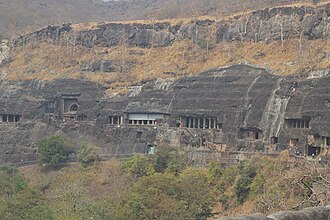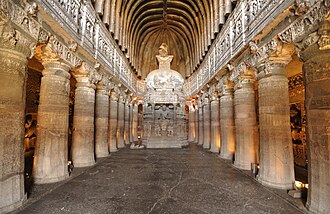Ajanta Caves: Difference between revisions
imported>Surya D. Bhattacharyya (Intro page. Will be adding more information with time.) |
Pat Palmer (talk | contribs) mNo edit summary |
||
| (8 intermediate revisions by 4 users not shown) | |||
| Line 1: | Line 1: | ||
{{subpages}} | |||
{{Image|Ajanta caves view.jpg|right|250|A view of the outside of the Ajanta caves in 2023.}} | |||
{{Image|Cave 26, Ajanta.jpg|right}250px|Cave 26, a Buddhist "Chaitya Griha" or prayer hall.}} | |||
The '''Ajanta Caves''' are a series of 29 Buddhist cave temples in [[Maharashtra]], [[India]]. The caves are a [[World Heritage site]]. Encompassing both [[Theravada]] and Mahayana [[Buddhism]], they represent some of the best masterpieces of Buddhist art in India. The caves “…numbered in an arbitrary sequence, are laid out in a great arc cut by the curving course of the Waghora river.”(p1, Spink) | |||
[ | The caves were used as prayer halls by Buddhist monks for about seven centuries until suddenly the monks disappeared and the caves were all that was left. Several theories exist as to why the caves had been abandoned. The most prominent and perhaps the most probable reason was the rise of Hinduism in the region. The caves were an accidental discovery made by a group of British soldiers in 1819. | ||
[[Category: | |||
==Footnotes== | |||
<small> | |||
#[http://www.sacred-destinations.com/india/ajanta-caves.htm ''A link to sacred-destinations.com''] | |||
#''Ajanta: History and Development'' by '''Walter M. Spink''' ''ISBN:9004156445'' (2007)[[Category:Suggestion Bot Tag]] | |||
<references> | |||
</references> | |||
</small> | |||
Latest revision as of 15:26, 13 August 2024
The Ajanta Caves are a series of 29 Buddhist cave temples in Maharashtra, India. The caves are a World Heritage site. Encompassing both Theravada and Mahayana Buddhism, they represent some of the best masterpieces of Buddhist art in India. The caves “…numbered in an arbitrary sequence, are laid out in a great arc cut by the curving course of the Waghora river.”(p1, Spink)
The caves were used as prayer halls by Buddhist monks for about seven centuries until suddenly the monks disappeared and the caves were all that was left. Several theories exist as to why the caves had been abandoned. The most prominent and perhaps the most probable reason was the rise of Hinduism in the region. The caves were an accidental discovery made by a group of British soldiers in 1819.
Footnotes
- A link to sacred-destinations.com
- Ajanta: History and Development by Walter M. Spink ISBN:9004156445 (2007)

